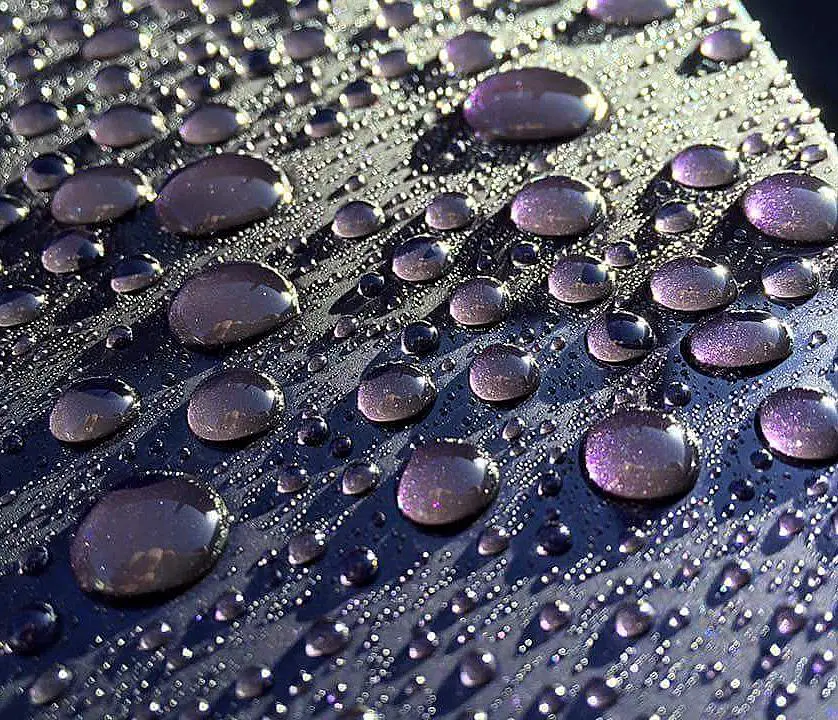Water beading on car is a phenomenon that has been the subject of much discussion in the automotive world.
It refers to the ability of water droplets to stick to each other and to the surface of a car, creating a beaded effect.
While this may seem like a minor detail, it can actually have a significant impact on the health of your car’s paint job.
In this article, we’ll explore the science behind water beading on car, its benefits and drawbacks, and how it can be fixed.
So, buckle up and let’s dive into the world of water beading on car!
Definition of Water Beading
Water beading is when a liquid sticks to tiny water molecules due to surface tension. This phenomenon provides added protection for your car against liquids and debris, such as rain or sprinklers.
Exploring Water Beading Versus Water Sheeting
When it comes to water repellency, both water beading and water sheeting share a common goal of repelling water through surface tension, a quality found in certain products.
While water beading adds an aesthetic touch, water sheeting offers practical advantages.
Water sheeting enables water to smoothly run off the car’s surface in continuous sheets. In some instances, it achieves this without any visible beading.
This characteristic is beneficial as it can effectively prevent or reduce the risk of damage to the car’s finish.
In essence, water sheeting provides a streamlined and efficient way to safeguard your vehicle from the potential harms associated with water exposure.
What Is The Science Behind Water Beading on Cars?
The science behind water beading on cars is rooted in the concept of surface tension.
Surface tension is the ability of a liquid to adhere or stick to the water molecules around it.
When a car’s surface has high surface tension, it causes water droplets to form into beads.
These beads are held together by the surface tension of the water molecules, which creates a protective layer on the car’s surface.
What Are The Benefits Of Water Beading on Cars?

Here are some benefits of water beading on car:
- Protection from water damage: Water beading on car offers your vehicle better protection from various liquid sources and debris, be it sprinklers or rain. The beaded water droplets roll off the surface of the car, taking with them any dirt, dust, or debris that may have accumulated on the surface. This helps to keep your car clean and free from contaminants that can damage the paint job.
- Improved visibility: Water beading on car can also improve visibility while driving in the rain. When water droplets bead up on the windshield, they are less likely to stick to the glass, which can help to improve visibility and reduce the need for windshield wipers.
- Easier cleaning: Water beading on car can make it easier to clean your car. The beaded water droplets roll off the surface of the car, taking with them any dirt, dust, or debris that may have accumulated on the surface. This means that you can spend less time cleaning your car and more time enjoying it.
- Long-lasting protection: Water beading on car can provide long-lasting protection for your car’s paint job. By creating a protective layer on the surface of the car, water beading can help to prevent damage from UV rays, acid rain, and other environmental factors that can cause paint to fade or peel.
What Are The Drawbacks Of Water Beading on Cars?
Here are some drawbacks of water beading on car:
- Scratches: If the water droplets are left to dry on the surface of the car, they can leave behind water spots that can etch permanently into the clear coat. Additionally, if the water droplets are not in motion, they can cause scratches on the surface of the car when wiped off.
- Stains: Water beading on car can also cause stains on the surface of the car. If the water droplets contain contaminants such as dirt, dust, or pollen, they can leave behind stains on the surface of the car that can be difficult to remove.
- Maintenance: Water beading on car requires regular maintenance to ensure that the surface of the car remains clean and free from contaminants. This can be time-consuming and may require the use of specialized cleaning products.
- False sense of security: Water beading on car can create a false sense of security for car owners. While it may seem like the car is protected from water damage, it is important to note that water beading can also have drawbacks that can damage the car’s paint job.
How do I stop my car from beading water?
To avoid bead water damaging your finish, here are some tips:
-
Wash your car regularly
Giving your car a regular wash is the best way to keep it free from harmful substances and corrosives that can damage the paint job. This will help to remove any dirt, dust, or debris that may have accumulated on the surface of the car.
-
Use a high-quality wax
Applying a high-quality wax to your car’s surface can help to protect it from water damage. The wax creates a barrier between the water droplets and the surface of the car, which helps to prevent water spots and other types of damage.
-
Dry your car after washing
After washing your car, be sure to dry it thoroughly with a soft, clean towel. This will help to prevent water spots from forming on the surface of the car.
-
Avoid parking under trees
Parking your car under trees can expose it to sap, bird droppings, and other substances that can damage the paint job. Try to park your car in a covered area or in a garage to protect it from these types of hazards.
-
Use a car cover
If you don’t have access to a covered area or garage, consider using a car cover to protect your car from the elements. A car cover can help to prevent water damage, as well as protect your car from other types of damage such as scratches and dings.
Is it good for water to bead on car?
The question of whether water beading is good for a car is a bit more complicated. On the one hand, water beading can be a sign that the car’s surface is well-protected by a layer of wax or sealant.
This layer can help prevent water from penetrating the paint and causing damage to the car’s body. On the other hand, water beading can also be a sign that the car’s surface is dirty or contaminated with pollutants.
In this case, the water droplets can actually cause damage to the car’s paint by etching into the surface and leaving behind water spots.
In general, it’s a good idea to keep your car clean and well-maintained to prevent water spots and other types of damage. Regular washing and waxing can help protect your car’s surface and keep it looking its best.
If you’re interested in achieving water beading on your car, you can use a good quality sealant that contains special ingredients to help create this effect. However, it’s important to note that water beading is not a guarantee of protection and should not be relied upon as the sole method of protecting your car’s surface.
How do you get water to bead on a car?
To get water to bead on a car, you can use a good quality sealant that contains special ingredients to help create this effect.
Regular washing and waxing can also help protect your car’s surface and keep it looking its best.
However, it’s important to note that water beading is not a guarantee of protection and should not be relied upon as the sole method of protecting your car’s surface.
FAQs
What causes water to bead on a car?
Water beading on a car is due to the surface tension of the water molecules and the hydrophobicity of the car’s surface. When water droplets form on a hydrophobic surface, they tend to bead up and roll off the surface rather than spreading out.
Is water beading a sign of a well-protected car surface?
Water beading can be a sign that the car’s surface is well-protected by a layer of wax or sealant. This layer can help prevent water from penetrating the paint and causing damage to the car’s body.
Can water beading cause damage to a car’s surface?
Water beading can also be a sign that the car’s surface is dirty or contaminated with pollutants. In this case, the water droplets can actually cause damage to the car’s paint by etching into the surface and leaving behind water spots.
How can I prevent water from beading on my car?
To prevent water from beading on your car, you can wash your car regularly, apply a protective coating such as wax or sealant, use a water softener if you live in an area with hard water, dry your car after washing, and park your car in a covered area.
What should I do if I have water spots on my car?
If you have water spots on your car, you can try removing them with a mixture of vinegar and water or a specialized water spot remover. Be sure to follow the instructions carefully and test the product on a small, inconspicuous area of your car before using it on the entire surface.
Conclusion
Water beading on car, a result of surface tension, can provide protection and aesthetic appeal.
While it shields the car from water damage, enhances visibility, and facilitates easier cleaning, drawbacks include potential scratches, stains, and the need for regular maintenance.
Achieving water beading requires proper washing, waxing, and use of quality sealants.
However, it’s not foolproof and may not always indicate a well-protected surface.
Preventive measures involve regular cleaning, high-quality wax application, and avoiding environmental hazards.
Ultimately, maintaining a clean and well-maintained car is crucial for preserving its appearance and protecting against potential damage.




